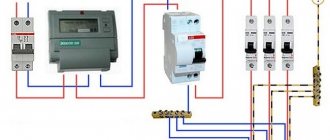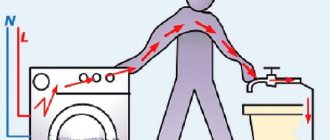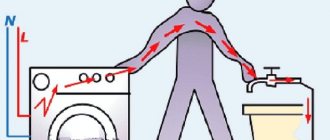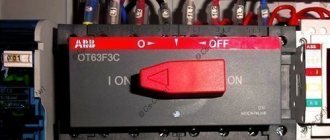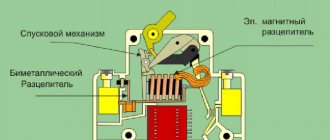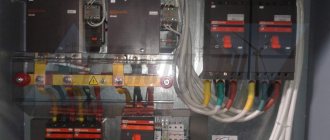The danger of fire from short circuit current, electrical injury caused by the appearance of a current load on the housings of household appliances, according to the “Rules for Electrical Installations,” requires protection by special devices mounted in the home electrical circuit. Automatic circuit breakers (CBs) for current load and RCDs (residual current devices) successfully cope with the function of ensuring electrical safety. However, when installing devices in previously installed electrical panels, problems arise due to lack of space. For such cases, difavtomats (abbreviated as “diffs” or abbreviated as RCBOs) are used, which combine the functions of a circuit breaker and an RCD in one housing. What is a differential machine, the features of this device are described in this article.
Operating principle and design of the automatic machine
In a dielectric housing, consisting of two parts, the elements of the RCD and the circuit breaker are located separately from each other, each in a specially designated place. A schematic diagram of how a typical differential machine works is shown in the image:
The modular circuit breaker unit consists of thermal and electromagnetic releases. The bimetallic plate of the thermal release is triggered by heating with an overload current, and the solenoid core of the electromagnetic release, by its movement, opens the circuit in the presence of a short circuit.
Another modular unit monitors the appearance of a current load, performing tasks solved by the RCD. Its main element is a differential transformer, in which, under normal operating conditions, the current of the primary winding is equal to the current of the secondary (the only difference is the direction vector). When a person touches, for example, a conductor with broken insulation, part of the current will not return through the secondary winding, but will go through the person to the ground. On it, due to a change in the magnetic flux, a voltage will be induced, which, when it reaches a certain value, sends a signal to the opening relay.
The difference between an ouzo and a differential machine according to its functional purpose
If you look at the RCD and the difavtomat, then in appearance these two devices are very similar to each other, but the functions they perform are different. Let's remember what functions the RCD and the differential circuit breaker perform.
The residual current device is triggered if a differential current—leakage current—appears in the network to which it is connected. When a leakage current occurs, the first person to be harmed is a person who touches damaged equipment. In addition, when a leakage current appears in the electrical wiring, the insulation will heat up, which can lead to ignition and fire.
Therefore, RCDs are installed to protect against electric shock, as well as damage to electrical wiring in the form of leaks that are accompanied by fire. For more details on how this device works, see the article on the principle of operation of an RCD.
Now let's look at the differential machine. This is a unique device that combines both a circuit breaker (more understandable to the population as a “machine”) and the previously discussed RCD. Those. a differential circuit breaker can protect your wiring from short circuits and overloads, as well as from leaks associated with the previously described situations.
Now the main point where everyone starts to get confused: remember that the RCD, unlike the automatic circuit breaker, does not protect the network from overload and short circuit. And most consumers think that by installing an RCD, they are protected from everything!
In simple terms, an RCD is simply an indicator that monitors leakage and that current does not flow past your main consumers: electrical appliances, light bulbs, etc. If somewhere in the network the insulation is damaged and a leakage current appears, the RCD reacts to this and turns off the network.
Read also: How to measure chainsaw chain pitch
If you turn on all electrical appliances (heaters, hair dryers, irons) at the same time, that is, deliberately create an overload, the RCD will not work. And the wiring, if there are no other protection devices, rest assured, will burn out along with the RCD. If, when the RCD is turned on, you connect phase and zero and get a huge short circuit, then the RCD will also not work.
Why do I mean all this, I just want to draw your attention to the fact that since the RCD does not protect the network from overloads and short circuits, you will probably agree with me that it itself needs to be protected. That is why the RCD is always connected in series with the machine. These two devices work in pairs, so to speak: one protects against leaks, the other against overloads and short circuits.
By using a difavtomat instead of an RCD, you get rid of the situations described above: it will protect against everything.
Let's summarize, the main difference between an RCD and a difavtomat is that the RCD does not protect the network from overloads and short circuits.
Main technical characteristics
In order not to make a mistake in choosing a difavtomat, you should be guided by the main technical characteristics. They represent varieties of parameters related to both circuit breakers and RCDs.
- Rated or operating voltage for single-phase or three-phase networks.
- The operating current, with its magnitude, the protective device is capable of operating for a long time.
- Instantaneous tripping current of the electromagnetic release. The “time-current” characteristics of difavtomats depend on the design of the device’s circuit breaker; they are mainly of types B, C, and D.
- Differential leakage current - shows the value at which the protection device will trip to disconnect the circuit.
- The differential reacts to the specific nature of the current source, which can be sinusoidal, pulsating or constant.
- According to the operating principle of the RCD actuator on differentials, it can be electronic or electromechanical.
- The differentials are performed with different response delays. The protective devices at the input have a longer time delay than those installed after the input. This selectivity creates the opportunity for the latter to operate the protective shutdown.
- The design of most differentials includes testing the RCD for operability, which is why there is a “TEST” button.
Conclusions and useful video on the topic
To better understand security devices and choose the right solution depending on the situation, we suggest watching thematic videos.
Interesting information about the operating principle and installation of RCDs:
Some tips from a professional electrician:
What played a role when choosing a difavtomat:
As you can see, the topic of choosing an RCD or RCBO is not in vain: there are many points that speak in favor of both devices. In order to correctly select the optimal protection option, it is necessary to consider the installation and connection conditions, as well as draw up a preliminary estimate.
Do you have anything to add or have any questions about the topic? You can leave comments on the publication, participate in discussions and share your own experience of using RCDs and differential circuit breakers. The communication block is below.
Most consumers do not care what is in front of them: RCD (residual current device) or difatomat (differential circuit breaker). But when developing electrical network projects for private houses or apartments, this issue has a certain significance.
In general, the problems that our citizens have with organizing the protection of their own homes in terms of electrical safety are significant. But what can we say if in many remote areas such things as “bugs” in traffic jams are still the norm?
Recently, one of my acquaintances asked me a question: what is in my panel, an RCD or a difavtomat? How to distinguish them. Since the problem, in a professional opinion, is very acute, we offer you a small educational program on this topic, including for electricians, especially young ones.
This knowledge will allow you to understand exactly what “lives” in your switchboard: an RCD or a circuit breaker, why place it there and how much it will help, or why it will save you in the future?
An experienced electrician, who has more than one short circuit under his belt, may even be offended by such questions! However, among young people, little attention is paid to theory, although consumers ask such questions all the time. And now I will tell you several options on how an RCD differs from a difavtomat .
Marking
The image shows the main letter and number symbols that are present for marking most difavtomats.
In the image, the residual current circuit breaker is designated by the abbreviation AVDT 63, where the numbers indicate the rated current of the device 63 A. The manufacturer's brand is indicated at the top. Below is the type of design of the RCD (here electronic).
Switching the residual current circuit breaker
Such equipment is connected in the same way - the input of the phase and neutral conductors is on top, and the voltage output to the apartment is below. The difference lies in the absence of the need to install the machine in front of the RCBO. It should be noted that if the phase and neutral conductors are connected incorrectly, causeless shutdowns may also occur, so you should pay close attention to the contact markings on the front panel. Information about the switching procedure for a particular device can be found in the diagram located on the side.
Non-standard verification options
It should be noted that the check does not apply to circuit breakers; it only applies to devices that respond to current leakage (RCD). To check for overload currents and short circuits, you need a laboratory option; this cannot be done at home.
In addition to the standard one, using a button, there are other ways to check the automatic machine.
- Check the differential machine in the usual way using a battery. The connection diagram is simple: the positive contact of the battery is connected to the input contact, the negative contact to the output:
By closing the contacts on the poles of the machine, we thereby create a magnetic disturbance on the windings of the differential transformer and the shutdown mechanism of a working differential is triggered. An effective way to choose a differential machine when buying it in a working condition in a store. - Checking functionality with a magnet. You should bring the magnet closer to the cocked RCBO - the differential protection device should turn it off.
Important: The RCD must operate under the influence of an electromagnetic field; this testing principle is not suitable for an electronic device.
- Selected resistance value. The resistance that is connected between the socket and the grounding device is determined using Ohm’s law, well-known in electrical engineering, R = U/I, where U is the input voltage (220 V or 380 V), I is the leakage current indicated on the circuit breaker. The resistance calculated in this way will cause a leakage current, at which it knocks out the automatic switch. By connecting a multimeter in series to the circuit and setting the operating mode to “ammeter”, you can monitor the circuit current readings.
- Electronic devices. The use of multifunctional electronic measuring instruments connected via a socket allows you to check several parameters of the automatic machine at once. In addition to determining operability, you can find out the response time and make sure that the leakage current value indicated on the body of the protective device is correct. However, it will be an expensive pleasure for the home.
Connecting protective automation in the distribution cabinet
Resolving this issue requires care and precision. It is not enough to know how to distinguish an RCD from a difavtomat. You need to be able to connect both of these devices correctly. Dear reader, you probably already realized that switching an RCD requires additional installation of the AV, so the circuit here is a little more complicated, but not so much that it is impossible to understand it. It is necessary to immediately note that to ensure reliable protection, both devices require high-quality and properly functioning grounding. It is worth carefully considering the question of how to connect the automatic circuit breaker and the RCD.
Designation of a difavtomat in a conventional form on a single-line diagram
“Rules for the technical operation of consumer electrical installations” regulate the creation of technical documentation that is as convenient as possible to use. One of them is a single-line diagram in a simplified form showing the connections of power lines, distribution points and the location of other electrical elements. So, there is no designation of a difavtomat on the diagram that corresponds to the regulatory documentation. With the tacit consent of users, they are designated as follows:
The letter designation of the differential machine in the diagram is in the form of Latin letters QF.
Manufacturers of protective devices popular among consumers
The number of companies offering similar products on the shelves of Russian stores is steadily growing. However, it is difficult for young brands to find their niche in the electrical appliances market. Popular among consumers are brands that have been producing protective equipment for many years and have already proven themselves to be good thanks to the quality and reliability of their products. One of such brands can be called ABB. This company has long been known to Russian buyers; people trust its products. Thanks to this, RCDs and ABB automatic circuit breakers do not sit on the shelves.
The only thing surprising is the pricing policy of the Italians, who produce products under this brand. The cost of devices with almost identical characteristics can differ significantly. For comparison, let’s take 2 ABB automatic circuit breakers with a rated current load of 16 A and triggering at a leakage of 30 mA. The price of the devices is (by model):
- DS901 – 1600 rub.
- DS201 – 5100 rub.
But ultimately, it’s up to the home craftsman to decide what to buy.
Criterias of choice
The main criterion for choosing a difatomat for an apartment will be its ability to provide the energy consumed by all electrical appliances. How to choose a difavtomat by power, whether one is enough or installing several will be shown by calculating the electricity consumption of household electrical appliances, taking into account the real time of their operation. As initial data, you can use information from technical data sheets or calculate according to the data indicated on the device body.
In addition to the calculation-related option, you can measure the power of a household electrical device using an energy meter. Why is it plugged into a socket, and why is the device itself connected to it? It will be labor-intensive, but simple, to put one device into operation for an hour at a time. By taking readings from the electric meter, we will get the necessary information. Choose a RCBO with technical characteristics corresponding to the calculated data.
The high reliability of operation of difavtomats is guaranteed by belonging to a brand that has won the trust of consumers with the impeccable quality of its products.
Foreign manufacturers include: Swedish-Swiss ABB, French LeGrand, Schneider Electric, German Siemens and others.
Among Russian manufacturers, the quality of which is inferior to those presented above includes the brands KEAZ, IEK, DEKraft and others.
Studying the ratings that are available on the Internet will help you choose which brand to choose.
RCD decoding in electrical
Some users do not fully understand what RCD means, the abbreviation for residual current device. A more accurate and modern name sounds like a residual current controlled protective device. In abbreviation it will be difavtomat UZO-D.
On the body of each device there are symbols that you need to know when deciphering the RCD and choosing the most suitable device model. The name or trademark of the manufacturer must be on the body of the device. Next to it is the standard designation of the device with its serial number.
The main parameters with nominal values are also marked on the body:
- Rated voltage Un in volts with one or more values.
- Rated current In in amperes with letter designation of instantaneous tripping type
- Rated frequency. Apply when the protective device is designed for operation at a frequency other than the traditional 50 or 60 Hz.
- The rated value of the differential breaking current IΔn or several such values, if provided for by the technical characteristics of the device.
- Rated making and breaking capacity Im. The rated differential making and breaking capacity may also be indicated if it differs from the standard value.
- Rated switching capacity Icn in amperes when short circuits occur.
There are other characteristics that are applied to the body and must be deciphered. All markings after installation of the RCD must be clearly visible. The parameters of some devices can be applied to the side and rear surfaces. They are visible only before installation and are entered into the operational documentation for subsequent use.
Advantages and disadvantages
The positive characteristics of difavtomats include the following.
- The fire safety of objects is increased - there is protection against overheating of electrical wiring.
- There is no need to install an RCD; its functions are performed by a similar device integrated into the differentials.
- It takes up minimal space in the input panel; single-module differential blocks are all compactly mounted on its DIN rail.
- Due to the reduction of contact groups, it is easy to install.
The device also has negative characteristics.
- Multifunctionality creates problems in determining the cause of the operation - from a short circuit or from a leakage current. Not all automatic machines are equipped with special indicators, the purpose of which is to indicate the designation of the critical factor. This makes it difficult to find, and therefore troubleshoot, the damaged section of the circuit.
- The failure of one of the components - a circuit breaker or RCD - leads to the replacement of the entire, inexpensive device itself. Economically, installing a separate RCD and circuit breaker is more profitable.
- It should be taken into account that electronic automatic devices lose their functionality if the neutral wire breaks. Attention: if the phase is energized, this may result in electric shock to a person. The electromechanical version of the difavtomat does not have this drawback.
The need for power grid protection
A home electrical system is a complex branched network consisting of many circuits - lighting, sockets, separate power and low-current circuits. It includes all electrical installations that have to be used daily. The simplest among them are sockets and switches.
During the operation of household electrical appliances, unforeseen situations arise, which result in the failure of individual circuits, devices, as well as accidents.
The causes of trouble are the following:
- excessive load on power lines;
- leakage currents;
- short circuits.
You can encounter overload if you use new powerful equipment in an apartment with old wiring. The cable cannot withstand the total load, overheats, melts and fails.
The danger of leakage currents appears when the insulation of electrical cables and devices becomes unusable, or the equipment is installed incorrectly or grounded.
If the current rises above 1.5 mA, the effects of electricity become noticeable, and more than 2 mA causes convulsions.
To protect equipment, property, and most importantly, the life and health of residents, emergency shutdown devices are used. Without them, a modern electrical wiring system in an apartment or private house is considered inferior and dangerous.
What is better - a difavtomat or an RCD?
This is an issue around which there is still a lot of controversy. It is the second most popular among Internet users, after the main one - how to distinguish an RCD from an automatic device. Specialists and home craftsmen were divided into 2 camps. The first claim that the installation of RCBOs is simpler; the device takes up less space in the panel, which automatically makes it more in demand. The latter, on the contrary, say that its universality is its problem. After all, when installing a RCD/AV combination, it is possible to replace only one unit if it fails, while if the RCBO breaks down, you will have to purchase more expensive equipment in its entirety. In addition, there is a problem with determining the cause of the trigger. It is not clear why the power supply was turned off - due to overload or leakage. If a ligament is installed, such a question does not arise.
You can argue on this topic for a long time, but there are cases when there is no other way out than installing a RCBO due to the lack of free modular space on the DIN rail. In such cases, the question “what is better” fades into the background, giving way to practicality.
How does an RCD with grounding work?
The residual current device is selected in accordance with the network configuration where it is planned to be installed. The presence or absence of a PE grounding conductor should be immediately determined. In modern buildings it is initially provided for by the design. At old buildings, the PEN scheme is still used, which involves combining the protective conductor with the neutral wire.
Installation of a connection to the ground is considered more effective, since the circuit is disconnected in this case immediately when a current leak occurs. In the PEN scheme, as already noted, shutdown occurs only after direct human contact with the equipment.
If there is still grounding in the circuit, then before installing the protective device, its type should be clarified. For example, the TN circuit assumes solid grounding of the neutral of the power source. Its variation is the TN-C circuit, which combines in a single wire the neutral working and protective conductors throughout the entire electrical circuit. This simple and inexpensive option has a significant drawback: in the event of a break in the PEN conductor, if the device has its own grounding, there is a danger that the entire potential will transfer to its body and the same voltage will appear on it as in the entire circuit.
Sometimes electricians use a jumper that shorts the neutral and ground terminals in the outlet. Such a scheme is considered incorrect and dangerous due to the high probability of electric shock. When the PEN wire breaks, the RCD will not trip, and dangerous voltage will appear on the device body. Injury can only be avoided by accident: at the moment of contact with a current-dangerous housing, a person must also touch the grounding circuit, for example, water supply or heating pipes.
The TN-S circuit is considered the most reliable for connecting an RCD, where the neutral protective conductor is connected separately. It is combined with the neutral only in the power source, which ensures maximum protection and almost completely eliminates the possibility of electric shock. Even if the neutral or ground wire breaks, all devices in the circuit will continue to work. Dangerous voltage will not appear on the housings, since the potential will transfer to the other, remaining wire. If two wires break at once, all devices and the circuit itself will not pose a danger to people, since the electricity will be completely turned off.
There is another so-called intermediate connection scheme TN-CS, when the neutral and ground wires can be combined only in separate sections and acquire the properties of a PEN conductor. In this case, installation of an RCD is mandatory, otherwise the circuit will be left without protection at all.
Time, current characteristics
How to properly connect an ammeter in a car
This parameter determines the ability to automatically withstand transient current surges. Those. During the startup process of electrical equipment, a current surge occurs in the network, so that the machine does not react to such sudden changes; it may differ in the design of the magnetic switch.
In general, there are three types of machines: category B - the machine can withstand short-term current exceeding five times the rated current, category C - ten times and category D - 20 times, respectively.
The choice of one category or another is determined by the type of load: active, inductive or capacitive.
General information about RCDs
We will not touch upon indexing issues, since for ordinary users the initial data is sufficient, on the basis of which the process of selecting a suitable protective device is carried out. Several steps must be performed to clearly understand the requirements for installing an RCD in a specific location:
- we decide on such a moment as the future connection of the selected model with an automatic machine or the automatic variant;
- the machine must always have rated current parameters higher than the cut-off current by one step. In the case of a difavtomat, these indicators should be the same;
- to calculate the cutoff value, the maximum current consumption indicator is taken and multiplied by a factor of 1.25. Then the resulting value with a table of the standard series of currents. If there is a difference with the characteristics indicated in it, we round up;
- An important nuance is to find out the permissible leakage current. With rare exceptions, in standard devices this figure is 30 or 100 mA. The type of wiring mainly influences our choice.
The location and type of secondary devices should be taken into account when installing a “fire” RCD.
Options for putting DIFs to work
The types of commissioning of differential automatic devices are completely different. The design of connection diagrams depends on various factors.
Things such as the location of the electrical instrument panel in the room, the location of the nearest grounding point, and also without access to it are taken into account.
- It is of great importance how many current phases the network has.
- Drawing up a connection diagram is also based on the design of the DIF, which has a two- or four-pole system.
Installation option number 1
Let's analyze a circuit with the presence of a single-phase current in the network and a grounding point. For the entire closed circuit of electricity flow in a given room, only one automatic circuit breaker is used. It is usually placed after the counter. In this case, the sequence of connecting the device structure is simple. When the DIF is triggered, the entire network service area of this device is de-energized. Here it is difficult to determine the cause of the power outage situation.
Installation option number 2
The same circuit with single-phase current and grounding, but slightly better. The meaning of its advantages is that we can now divide a large room into different groups for connecting several differential switches.
This is a more convenient connection design that allows you to disconnect the area of the room where the emergency occurred.
The only downside to this is that you need to buy additional DIFs. As you know, convenience requires more costs and increases your own safety.
Installation option number 3
Now let's look at how to connect a machine without grounding. This version was used both in the private sector and in high-rise residential buildings of old construction.
Those standards did not include the mandatory use of grounding during the construction of buildings; the line had two wires, phase and neutral.
- When working with this version of the circuit, you need to take into account that it will trigger a short circuit in the current circuit, preventing damage to electrical appliances.
- For a person, the lack of grounding is life-threatening, but modern automatic devices have high performance indicators that can prevent the effects of electric current on the body in such a situation.
Very often, when there are guests who permanently live in houses with old-style wiring, electrical experts recommend replacing it with a safer one in accordance with modern requirements. It must have an additional grounding element throughout the room in the current network.
Installation option number 4.
This type of connection is called selective. The network also has one phase. This method of connecting devices is used when they want to unite several premises owners.
A selective differential automatic machine is used here; all the differential circuits are connected to it according to the diagram. The advantage of this type is that only the damaged compartment on the current line is disconnected. All other voltage supply groups will work without interruption.
Installation option number 5
An interesting connection method for a network with 3 phases. This requires a differential circuit breaker designed for such a network.
Its connection diagram is basically no different from the previous ones, except that there are more outputs and inputs in this device.
The priority of this method is given to those electricity users who have electrical appliances operating at high voltage in their homes.
For what reasons can a difavtomat work?
When using a protective device, it is important to understand in what cases it may operate.
Taking these nuances into account, it is worth making a decision about the cause of the problem (short circuit, leakage current, etc.).
Let's look at each option in more detail:
Tripping without load.
Older homes with poor wiring have serious insulation problems.
The latter is worn out and there is a high risk of leakage currents, the magnitude of which can vary taking into account many parameters - the presence of nearby animals, humidity level, and so on.
In such a situation, the AVDP may trigger falsely.
The cause of the problem may be:
- Damaged insulation;
- Presence of twists;
- Miscalculations in the location of distribution boxes;
- Electrical accessories.
To identify the cause, a wiring audit is required. You need to start with diagnosing the location of the damage.
For example, if the automatic switch goes off when the light bulb is turned on, the problem must be looked for in the lighting circuit.
If the AVDP is triggered after connecting some device to the outlet, you should make sure that this device is working properly.
When the “zero” and “ground” are short-circuited.
If for any reason the N and PE wires touch each other, there is a high risk of the differential circuit breaker tripping. Common places for short circuits are in the electrical box or in the outlet box.
The triggering logic is based on the operating principle of the device. If neutral and ground are combined, the current is split between the two conductors. Accordingly, there is no equality of currents in the differential transformer, and it perceives this fact as a leak.
This problem is often encountered by novice craftsmen who do not have the proper experience in servicing the automatic machine.
- At the moment the load is turned on. If the AVDP operates when the load is connected, the problem must be looked for in the insulation. It is unsafe to use wiring with such a fault, so it is recommended to call a specialist and deal with the problem. If you ignore it, there is a high risk of one of your family members becoming energized or causing a fire.
- During voltage surges. The logic of the difavtomat is designed in such a way that a shutdown can occur in the event of an increase in voltage. True, not all devices have this option, but only those with an electronic circuit. In addition, the protection can work during a short circuit inside the consumer, because the automatic circuit breaker can turn off in this type of accident.
Competent installation
In fact, the machine is much simpler and more logical to connect than is commonly thought
But the process should be treated with maximum attention and responsibility.
The following steps are important:
- Preliminary assessment of the appearance of the product. Inspect the surface, check for damage and cracks. If any are found, it is better to exchange the device, as it may not be suitable.
- Complete power outage and check with a multimeter.
- Fastening on a DIN rail. The automatic differential must be fixed, as shown in the photo below.
- Cleaning the ends of wires using special devices and insulation.
- The connection process is carried out from above, through the cores.
- Before turning on the power, the device must be firmly secured to the surface.
The disconnection of one device when another is triggered indicates an incorrect connection. Most often this happens when connecting zero and phase to different devices.
The automatic machine, which was connected by connecting “L” and “N” from below, will also not be operational. Be sure to connect from the top, as shown in the diagrams.
Now let’s formulate the main mistakes when connecting differential automatic machines:
Sometimes, after installation is complete, the device refuses to work, or turns off due to additional extraneous loads. The table shows typical errors of unprofessional installation:
Finally, we note that electricity is not a concept where savings are appropriate. After all, his work is connected with the lives and safety of people. All components, not to mention the devices themselves, must only be branded, purchased from reputable manufacturers. Before making a purchase, be sure to study all product characteristics.
A differential circuit breaker is a switching device that combines a circuit breaker and a residual current device (RCD).
There is an opinion that a circuit with a differential circuit breaker without grounding is inappropriate. Electricians motivate this by the fact that the wiring is usually made in a two-wire standard, and the absence of a difavtomat will require expensive modernization. However, this opinion cannot be considered correct, since the machine has only a couple of contact connectors, and there is simply no room to install a grounding conductor. In addition, the operating principle of protective systems does not require grounding. Below we will talk about the nuances of the operation of protective devices and how to connect a difavtomat without grounding.



